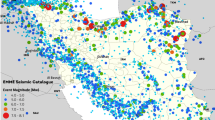Abstract
Recent earthquakes such as the Haiti earthquake of 12 January 2010 and the Qinghai earthquake on 14 April 2010 have highlighted the importance of rapid estimation of casualties after the event for humanitarian response. Both of these events resulted in surprisingly high death tolls, casualties and survivors made homeless. In the Mw = 7.0 Haiti earthquake, over 200,000 people perished with more than 300,000 reported injuries and 2 million made homeless. The Mw = 6.9 earthquake in Qinghai resulted in over 2,000 deaths with a further 11,000 people with serious or moderate injuries and 100,000 people have been left homeless in this mountainous region of China. In such events relief efforts can be significantly benefitted by the availability of rapid estimation and mapping of expected casualties. This paper contributes to ongoing global efforts to estimate probable earthquake casualties very rapidly after an earthquake has taken place. The analysis uses the assembled empirical damage and casualty data in the Cambridge Earthquake Impacts Database (CEQID) and explores data by event and across events to test the relationships of building and fatality distributions to the main explanatory variables of building type, building damage level and earthquake intensity. The prototype global casualty estimation model described here uses a semi-empirical approach that estimates damage rates for different classes of buildings present in the local building stock, and then relates fatality rates to the damage rates of each class of buildings. This approach accounts for the effect of the very different types of buildings (by climatic zone, urban or rural location, culture, income level etc), on casualties. The resulting casualty parameters were tested against the overall casualty data from several historical earthquakes in CEQID; a reasonable fit was found.
Similar content being viewed by others
References
Allen TI, Wald DJ, Hotovec AJ, Lin K, Earle PS, Marano KD (2008) An Atlas of ShakeMaps for selected global earthquakes. U.S. Geological Survey Open-File Report 2008-1236, 47 p
Boore DM, Joyner WB, Fumal TE (1997) Equations for estimating horizontal response spectra and peak acceleration from Western North American earthquakes: a summary of recent work. Seismol Res Lett 68/1: 128–153
Coburn A, Spence R (2002) Earthquake protection. Wiley, London
Dobson JE, Bright EA, Coleman PR, Bhaduri BL (2003) LandScan: a global population database for estimating populations at risk. In: Mesev V (ed) Remotely Sensed Cities. Taylor & Francis, London, pp 267–281
GEM, Global Earthquake Model. http://www.globalquakemodel.org/. Accessed 21 Feb 2011
Grünthal, G (eds) (1998) European macroseismic scale 1998. Council of Europe, Luxembourg
Jaiswal KS, Wald DJ (2008) Creating a global building inventory for earthquake loss assessment and risk management. U.S.G.S. Open File Report 2008-1160
Jaiswal KS, Wald DJ (2010) Development of a semi-empirical loss model within the USGS prompt assessment of global earthquakes for response (PAGER) system. In: Proceedings of the 9th US and 10th Canadian conference on earthquake engineering: reaching beyond borders, 25–29 July 2010, Toronto, Canada
Jaiswal KS, Wald DJ, Hearne M (2009) Estimating casualties for large worldwide earthquakes using an empirical approach. U.S. Geological Survey Open-File Report 2009-1136
Jaiswal K, Wald D, Earle P, Porter K, Hearne M (2011) Earthquake casualty models within the USGS prompt assessment of global earthquakes for response (PAGER) system, chapter 6. In: Spence R, So E, Scawthorn C (eds) Human casualties in earthquakes: progress in modelling and mitigation. Springer, Berlin
Koyama M, Okada S, Ohta Y (2011) Major factors controlling earthquake casualties as revealed via a diversified questionnaire survey in Ojiya City for the 2004 mid-Niigata earthquake, chapter 14. In: Spence R, So E, Scawthorn C (eds) Human casualties in earthquakes. Springer, Berlin
Lagomarsino S, Giovinazzi S (2006) Macroseismic and mechanical models for the vulnerability assessment of current buildings. Bull Earthq Eng, Special Issue “Risk-Ue Project” 4(4)
National Institute of Building Sciences-Federal Emergency Management Agency (NIBS-FEMA) (2006) HAZUS-MH MR2 technical manual
Petal MA (2004) Urban disaster mitigation and preparedness: the 1999 Kocaeli earthquake. PhD dissertation, University of California, Los Angeles
Pomonis A, Kappos A, Panagopoulos G, Karababa F (2011) Seismic vulnerability and collapse probability assessment for Greek buildings, chapter 11. In: Spence R, So E, Scawthorn C (eds) Human casualties in earthquakes: progress in modelling and mitigation. Springer, Berlin
Porter KA (2009) Cracking an open safe: HAZUS vulnerability functions in terms of structure—independent spectral acceleration. Earthq Spectra 25(2): 361–378
Spence R (ed) (2007) Human losses, chapter 5 in earthquake disaster scenario prediction and loss modeling for urban areas. LessLoss report no. 2007/07, pp 51–58
Spence RJS, So E (2010) A global earthquake building damage and casualty model, chapter 5. In: Spence R, So E, Scawthorn C (eds) Human casualties in earthquakes: progress in modelling and mitigation. Springer, Berlin
So E (2009) The assessment of casualties for earthquake loss estimation. PhD thesis, University of Cambridge, Cambridge
Trendafiloski G, Wyss M, Rosset P (2011) Loss estimation module in the second generation software QLARM, chapter 7. In: Spence R, So E, Scawthorn C (eds) Human casualties in earthquakes: progress in modelling and mitigation. Springer, Berlin
Wald DJ, Quitoriano V, Heaton TH, Kanamori H (1999) Relationships between peak ground acceleration, peak ground velocity and modified Mercalli intensity in California. Earthq Spectra 15/3: 557–565
Wald DJ, Lin K, Quitoriano V (2008) Quantifying and qualifying ShakeMap uncertainty. U.S. Geological Survey Open-File Report 2008-1238, 27 p
Wald DJ, Jaiswal KS, Marano KD, Bausch, DB, Hearne MG (2010) PAGER—Rapid assessment of an earthquake’s impact. U.S. Geological Survey Fact Sheet 2010–3036, 4p
WHE, World Housing Encyclopedia. www.world-housing.net. Accessed 10 Oct 2010
Worden CB, Wald DJ, Allen TI, Lin K, Garcia D, Cua G (2010) A revised ground-motion and intensity interpolation scheme for ShakeMap. Bull Seismol Soc Am 100(6): 3083–3096
Author information
Authors and Affiliations
Corresponding author
Rights and permissions
About this article
Cite this article
So, E., Spence, R. Estimating shaking-induced casualties and building damage for global earthquake events: a proposed modelling approach. Bull Earthquake Eng 11, 347–363 (2013). https://doi.org/10.1007/s10518-012-9373-8
Received:
Accepted:
Published:
Issue Date:
DOI: https://doi.org/10.1007/s10518-012-9373-8




